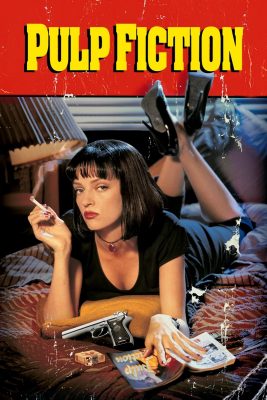
The storytelling of Pulp Fiction unfolds in a non-linear fashion, revolving around three main interconnected narratives featuring different protagonists: Vincent Vega, a hitman; Butch Coolidge, a boxer; and Jules Winnfield, Vincent’s partner. The film opens with a diner heist, proceeds to transition between various storylines, and eventually circles back to the diner scene for the conclusion.
The Web of Characters and Stories
There are seven narrative sequences in the film, each with a different focus but all intricately woven into the grand narrative of Pulp Fiction:
- “Prologue – The Diner” (i)
- Prelude to “Vincent Vega and Marsellus Wallace’s Wife”
- “Vincent Vega and Marsellus Wallace’s Wife”
- Prelude to “The Gold Watch” (a – flashback, b – present)
- “The Gold Watch”
- “The Bonnie Situation”
- “Epilogue – The Diner” (ii)
If arranged chronologically, the sequences would follow a different order. This unique episodic narrative structure, described as a “circular narrative,” allows for references to various episodes throughout the film.
Vincent and Jules: Hitmen with a Briefcase
Hitmen Jules Winnfield and Vincent Vega arrive at an apartment to retrieve a briefcase for their boss, Marsellus Wallace. After Vincent verifies the contents of the case, Jules executes one of Brett’s associates, followed by Brett himself for attempting to double-cross Marsellus. After a miraculous escape from a surprise attacker, they accidentally kill their car passenger, Marvin, forcing them to clean the car and dispose of Marvin’s body with the help of a professional cleaner, Winston Wolfe.
Divine Intervention and a Diner Hold-Up
At a diner, Jules reveals his intention to retire from crime, attributing their recent survival to divine intervention. As a couple, “Pumpkin” and “Honey Bunny,” attempt to rob the diner and seize Marsellus’s briefcase, Jules manages to defuse the situation and lets the robbers go. Jules and Vincent then leave the diner with the briefcase, ready to deliver it to Marsellus.
A Night with Marsellus’s Wife, Mia
Vincent, tasked with escorting Marsellus’s wife, Mia, while Marsellus is away, buys heroin from his dealer, Lance. After a twist dance contest at a 50s-themed restaurant, Mia accidentally overdoses on Vincent’s heroin, mistaking it for cocaine. Vincent manages to save her with a shot of adrenaline and agrees with Mia never to disclose the incident to Marsellus.
Butch’s Betrayal and Escape
Boxer Butch Coolidge, bribed by Marsellus to lose his upcoming match, instead bets the bribe money on himself and wins, accidentally killing his opponent. Fleeing from Marsellus’s revenge, he returns to his apartment to retrieve a family heirloom – a gold watch. In his apartment, he unexpectedly finds Vincent and kills him. After a car chase and shootout with Marsellus, both end up in a pawnshop where they are captured and held hostage.
The Unlikely Rescue and Departure
The shop owner, Maynard, and his accomplice Zed, take Marsellus away to assault him, leaving Butch watched over by a gimp. Managing to free himself, Butch chooses to rescue Marsellus, killing Maynard and leaving Marsellus to deal with Zed. Grateful, Marsellus lets Butch go on the condition that he leaves Los Angeles and never speaks of the incident. Butch picks up his girlfriend Fabienne, and the two of them ride away on Zed’s motorcycle, leaving behind the city of Los Angeles and the traumatic incidents that unfolded there. This marks a fresh start for Butch, having successfully managed to outwit Marsellus, escape his wrath, and maintain possession of his cherished family heirloom.
Review
“Pulp Fiction” is a 1994 American neo-noir crime film directed by Quentin Tarantino and starring John Travolta, Uma Thurman, and Samuel L. Jackson. The movie is a non-linear narrative that tells the interwoven stories of Los Angeles criminals over several days, with a focus on the criminal underworld and the culture of violence.
The film is a genre-defining work of American cinema, with its nonlinear storytelling, witty dialogue, and pop culture references making it a cult classic. It has become a defining work of the crime genre, inspiring countless imitators and solidifying Tarantino’s place as one of the most influential filmmakers of his generation.
The film’s visual style, from its use of lighting and color to its unconventional camera angles and framing, is masterfully executed, creating a unique and immersive cinematic experience. The use of nonlinear storytelling and non-chronological order adds to the film’s sense of tension and drama, keeping the audience engaged and guessing.
The movie’s screenplay, written by Tarantino himself, is a classic example of the unconventional storytelling techniques proposed by Robert McKee. The use of non-linear storytelling and unconventional structure serves to keep the audience on their toes, never quite sure what will happen next. The film’s exploration of the criminal underworld and the culture of violence is both insightful and entertaining, with Tarantino’s trademark wit and humor providing a counterpoint to the darker aspects of the story.
The characters are complex and well-rounded, with their motivations and personalities evolving throughout the movie. The film’s exploration of the moral ambiguity of its characters and their relationships with each other is an example of complex and nuanced character development that adds emotional depth to the story.
The film’s use of music is also noteworthy, with its eclectic soundtrack featuring a mix of pop, rock, and soul music, adding to the film’s overall sense of style and attitude. The use of music as a storytelling device is particularly effective in the film’s climactic scenes, adding a layer of emotional depth to the already intense visuals and performances.